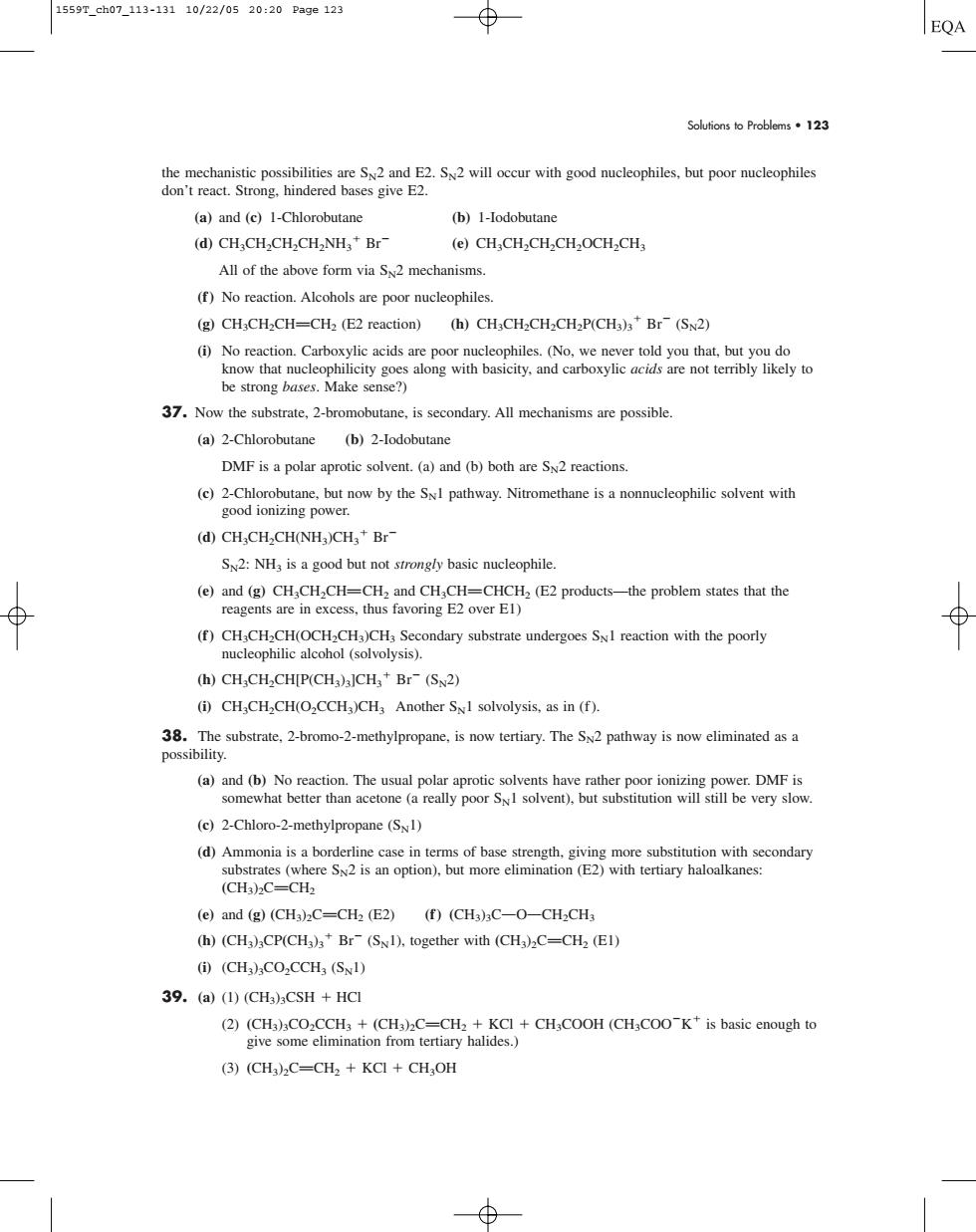正在加载图片...

1559T_ch07-113-13110/22/0520:20Pa9e123 EQA Solutions to Problems.123 echanistic ssibilities ar (a)and (c)1-Chlorobutane (b)1-Iodobutane (d)CHCH,CH,CH,NH,Br (e)CH,CH,CH,CH,OCH,CH, All of the above form via S2 mechanisms. (f)No reaction.Alcohols are poor nucleophiles (g)CH CHCH=CH2(E2 reaction) (h)CHCH,CH CH P(CH)Br(SN2) (i)No reaction.Carboxylic acids are ucleophiles.(No u do know that nucleophilicity g be strong bases.Make sense?) 37.Now the substrate,2-bromobutane,is secondary.All mechanisms are possible. (a)2-Chlorobutane (b)2-Iodobutane DMF is a polar aprotic solvent.(a)and (b)both are S2 reactions (c)2-Chlorobutane,but now by the Spathway.Nitromethane is a nonnucleophilic solvent with good ionizing power. (d)CH CH CHONH CH,Br Sx2:NHs is a good but not strongly basic nucleophile. ()e (h)CH,CH,CHIP(CH)ICH Br(SN2) (i)CH CHaCH()CH Another S solvolysis,as in (f) 38.The substrate,2-bromo-2-methylpropane,is now tertiary.The S2 pathway is now eliminated as a possibility. r DME i (e)2-Chloro-2-methylpropane (S) (d)Ammonia is a borderline case in terms of base s substitution with secondary substrates (whereS2isn option).but more imination(E2)with tertiary haloalkanes: (CH3C=CH (e)and (g)(CH3)2C=CH2 (E2) (f)(CHaC-O-CH-CH (h)(CH3)aCP(CHa)3*Br-(SsD).together with(CHa)2C-CH2(EI) (CHC0CCH3Sl) 39.(a)(1)(CH3)CSH HCI (3)(CH)C=CH,KCI+CHOH the mechanistic possibilities are SN2 and E2. SN2 will occur with good nucleophiles, but poor nucleophiles don’t react. Strong, hindered bases give E2. (a) and (c) 1-Chlorobutane (b) 1-Iodobutane (d) CH3CH2CH2CH2NH3 Br (e) CH3CH2CH2CH2OCH2CH3 All of the above form via SN2 mechanisms. (f ) No reaction. Alcohols are poor nucleophiles. (g) CH3CH2CHPCH2 (E2 reaction) (h) CH3CH2CH2CH2P(CH3)3 Br (SN2) (i) No reaction. Carboxylic acids are poor nucleophiles. (No, we never told you that, but you do know that nucleophilicity goes along with basicity, and carboxylic acids are not terribly likely to be strong bases. Make sense?) 37. Now the substrate, 2-bromobutane, is secondary. All mechanisms are possible. (a) 2-Chlorobutane (b) 2-Iodobutane DMF is a polar aprotic solvent. (a) and (b) both are SN2 reactions. (c) 2-Chlorobutane, but now by the SN1 pathway. Nitromethane is a nonnucleophilic solvent with good ionizing power. (d) CH3CH2CH(NH3)CH3 Br SN2: NH3 is a good but not strongly basic nucleophile. (e) and (g) CH3CH2CHPCH2 and CH3CHPCHCH2 (E2 products—the problem states that the reagents are in excess, thus favoring E2 over E1) (f ) CH3CH2CH(OCH2CH3)CH3 Secondary substrate undergoes SN1 reaction with the poorly nucleophilic alcohol (solvolysis). (h) CH3CH2CH[P(CH3)3]CH3 Br (SN2) (i) CH3CH2CH(O2CCH3)CH3 Another SN1 solvolysis, as in (f). 38. The substrate, 2-bromo-2-methylpropane, is now tertiary. The SN2 pathway is now eliminated as a possibility. (a) and (b) No reaction. The usual polar aprotic solvents have rather poor ionizing power. DMF is somewhat better than acetone (a really poor SN1 solvent), but substitution will still be very slow. (c) 2-Chloro-2-methylpropane (SN1) (d) Ammonia is a borderline case in terms of base strength, giving more substitution with secondary substrates (where SN2 is an option), but more elimination (E2) with tertiary haloalkanes: (CH3)2CPCH2 (e) and (g) (CH3)2CPCH2 (E2) (f ) (CH3)3COOOCH2CH3 (h) (CH3)3CP(CH3)3 Br (SN1), together with (CH3)2CPCH2 (E1) (i) (CH3)3CO2CCH3 (SN1) 39. (a) (1) (CH3)3CSH HCl (2) (CH3)3CO2CCH3 (CH3)2CPCH2 KCl CH3COOH (CH3COOK is basic enough to give some elimination from tertiary halides.) (3) (CH3)2CPCH2 KCl CH3OH Solutions to Problems • 123 1559T_ch07_113-131 10/22/05 20:20 Page 123������������